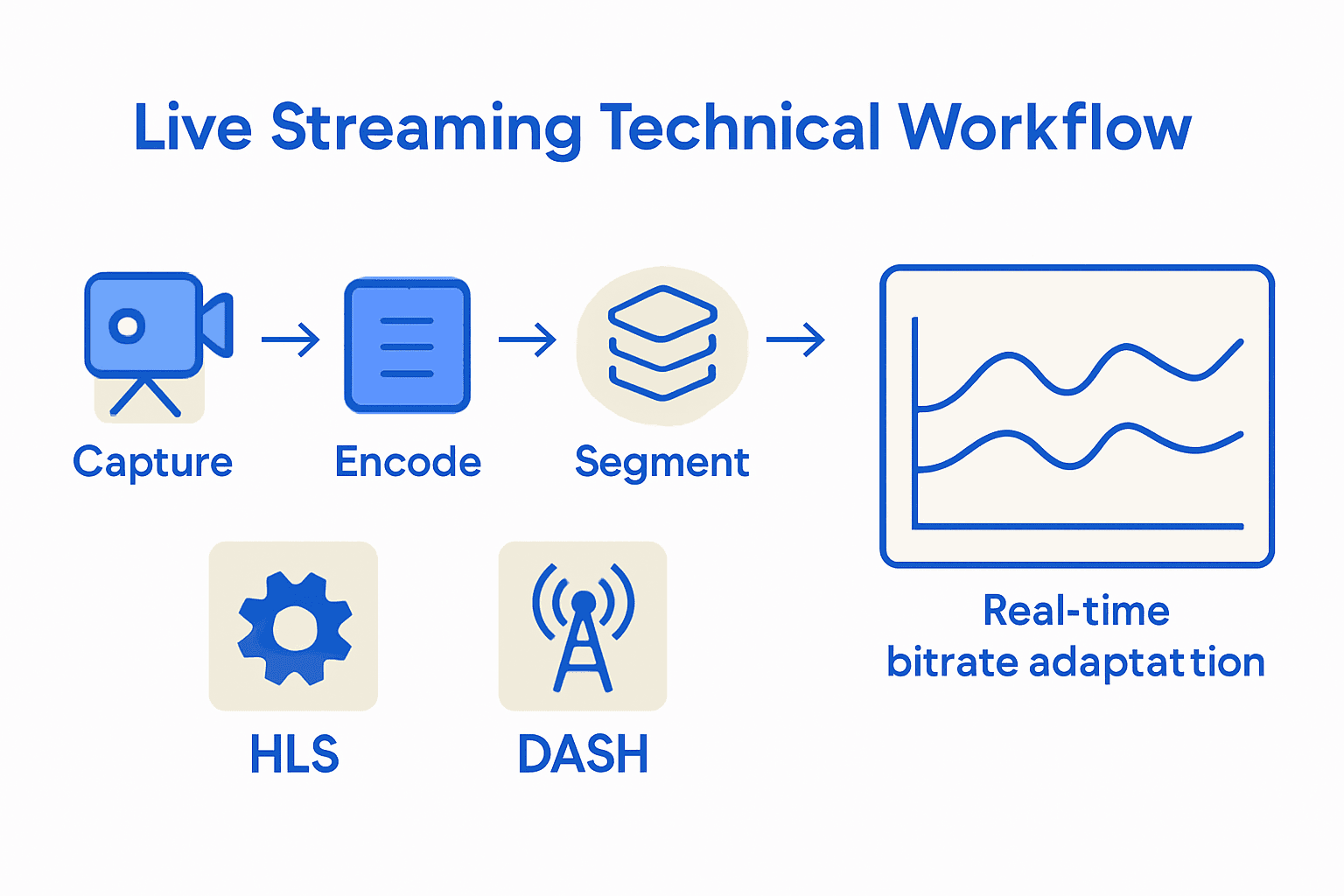Table des matières
More than 60 percent of american viewers say they watch live streaming content regularly, making it a powerful part of today’s digital life. Whether you are a creator or an audience member, understanding live streaming goes far beyond hitting the start button. This guide sheds light on how live streaming really works, the technology that powers it, and why so many american creators are embracing real-time connections to grow their audiences.
Table des matières
- What Live Streaming Actually Is
- Live Streaming Protocols Compared
- Technical Workflow Of Live Streaming
- Requirements For Creators To Stream
- Risks, Safety, And Legal Considerations
- Alternatives And Emerging Technologies
Principaux enseignements
| Point | Details |
|---|---|
| Real-time Engagement | Live streaming offers immediate audience interaction and authentic content delivery, enhancing viewer experience. |
| Adaptive Streaming Protocols | Utilizing protocols like DASH and HLS ensures optimized video quality based on viewer’s internet speed, improving overall streaming performance. |
| Technical Requirements | Creators need high-performance hardware and robust internet connectivity to successfully deliver quality live streams. |
| Legal and Safety Considerations | Navigating risks such as privacy concerns and copyright issues is crucial for creators to maintain a responsible online presence. |
What live streaming actually is
Diffusion en direct is a real-time digital broadcasting method that enables creators to transmit video and audio content directly to an online audience instantaneously. Unlike pre-recorded videos, live streams happen in the moment, creating an immediate and interactive experience for viewers.
According to research from arxiv.org, live streaming differs fundamentally from on-demand content through its unique real-time characteristics. The technology enables creators to broadcast events, performances, tutorials, and personal interactions as they happen, with minimal delay between production and consumption. Key features of live streaming include:
- Immediate audience engagement
- Real-time interaction through chat functions
- Unedited, authentic content delivery
- Communication directe entre le créateur et le spectateur
The technical infrastructure behind live streaming involves complex HTTP Adaptive Streaming (HAS) techniques, which dynamically adjust video quality based on viewers’ internet connection speeds. This ensures a smooth viewing experience across different devices and network conditions. Whether you’re a content creator on platforms like OnlyFans or a performer on live streaming sites, understanding these technological nuances helps optimize your broadcast quality and audience reach.
Live streaming protocols compared
Streaming protocols are critical technologies that enable seamless digital content transmission across various networks and devices. These complex communication frameworks determine how video data is packaged, transmitted, and received by viewers, directly impacting streaming quality and user experience.
Research from ijfmr.com provides a comprehensive analysis of two primary adaptive streaming protocols: Dynamic Adaptive Streaming over HTTP (DASH) et HTTP Live Streaming (HLS). These protocols have distinct architectural approaches to managing video delivery:
- DASH: Developed as an international standard, offering platform-independent streaming
- HLS: Apple’s proprietary protocol, natively supported on iOS and macOS devices
- Both support adaptive bitrate streaming to adjust video quality in real-time
- Capable of handling variable network conditions

Selon le jtit.pl, these protocols significantly outperform traditional streaming methods like Real-time Transport Protocol (RTP). The comparative study highlights how modern streaming protocols dynamically adjust video quality based on viewers’ internet speed, ensuring a smooth viewing experience. Learn more about live streaming technologies in our comprehensive content guide.
Technical workflow of live streaming
Diffusion en direct represents a complex technological process that transforms raw audiovisual content into a seamless digital experience for viewers across multiple platforms and devices. The technical workflow involves multiple intricate stages that work together to deliver real-time content with minimal latency and maximum quality.
Research from arxiv.org highlights the critical role of transport protocol performance in live streaming, particularly focusing on congestion control mechanisms. The technical workflow typically encompasses these essential stages:
- Content Capture: Converting physical audio/video signals into digital format
- Encoding: Compressing digital signals for efficient transmission
- Segmentation: Breaking content into smaller, manageable data packets
- Transmission: Sending data through network infrastructure
- Adaptive Streaming: Dynamically adjusting video quality
Selon le arxiv.org, the adaptation logic plays a crucial role in determining Quality of Experience (QoE). Modern streaming systems use sophisticated algorithms to continuously monitor network conditions, adjusting video quality in real-time to ensure smooth playback.
Learn more about interactive streaming techniques in our comprehensive creator guide, which explores the nuanced technological processes behind successful live content delivery.
Requirements for creators to stream
Diffusion en direct demands a strategic combination of technical equipment, digital infrastructure, and personal expertise. Creators must carefully assess their hardware, software, and network capabilities to deliver high-quality content that engages and retains their audience.

Research from pubmed.ncbi.nlm.nih.gov highlights the critical importance of choosing appropriate streaming protocols like Web Real-Time Communication (WebRTC) for seamless content delivery. Essential technical requirements for creators include:
- High-performance computer or dedicated streaming device
- Reliable high-speed internet connection (minimum 5 Mbps upload speed)
- Professional-grade microphone and camera
- Robust streaming software or platform
- Stable network infrastructure
- Adequate lighting and sound equipment
Selon le science.lpnu.ua, successful streaming hinges on understanding complex data transmission protocols and managing potential technical challenges. Creators must be prepared to troubleshoot connectivity issues and adapt their streaming setup dynamically. Learn more about maximizing your streaming potential in our comprehensive benefits guide, which offers invaluable insights for both novice and experienced content creators.
Risks, safety, and legal considerations
Diffusion en direct introduces complex legal and safety challenges that creators must carefully navigate to protect themselves and their audience. The digital landscape demands a proactive approach to managing potential risks associated with online content creation and transmission.
Research from Wikipedia highlights the critical security vulnerabilities inherent in real-time data transmission protocols like Real-time Transport Protocol (RTP). Key risks and legal considerations for creators include:
- Personal data protection and privacy concerns
- Potential copyright infringement issues
- Age verification and content restrictions
- Intellectual property rights management
- Platform-specific legal compliance requirements
- Potential exposure to online harassment
Creators must implement robust security measures to mitigate these risks, including secure streaming configurations, clear content guidelines, and proactive audience management strategies. Maintaining transparent communication and understanding platform-specific legal frameworks is essential for sustainable and responsible content creation. Learn more about navigating content monetization challenges in our comprehensive guide, which provides critical insights for protecting your digital presence and professional reputation.
Alternatives and emerging technologies
Live streaming technology continues to evolve rapidly, with innovative protocols and techniques emerging to address the growing demands of content creators and viewers. These emerging technologies aim to solve traditional limitations in video transmission, offering improved performance and user experience.
Research from Wikipedia highlights the High Efficiency Streaming Protocol (HESP), an advanced HTTP-based adaptive bitrate streaming technology that delivers sub-second latency. Key emerging streaming alternatives include:
- High Efficiency Streaming Protocol (HESP)
- WebRTC for real-time communication
- Secure Reliable Transport (SRT)
- Advanced peer-to-peer streaming networks
- Machine learning-enhanced adaptive streaming
- Edge computing-powered content delivery
Selon le Wikipedia, Secure Reliable Transport (SRT) represents a significant breakthrough, utilizing UDP for low-latency streaming with robust packet recovery and encryption capabilities. These emerging technologies promise to revolutionize how creators distribute content, offering more reliable, secure, and efficient streaming experiences. Learn more about interactive streaming advantages in our comprehensive guide, which explores cutting-edge developments in digital content transmission.
Elevate Your Live Streaming Experience with FanSpicy
If you have explored “How Live Streaming Works: Complete Guide,” you know the challenges creators face with technical setups, real-time audience engagement, and maintaining high-quality broadcasts. Issues like selecting the right streaming protocols, managing network stability, and ensuring seamless interactive communication can feel overwhelming. You deserve a platform designed to simplify these complexities while empowering your creativity.
At FanSpicy, we offer a paid social media and live cam platform built specifically as an OnlyFans alternative that supports reliable live streaming with optimized technology. Our service accommodates high-performance streaming needs with the ease of professional-grade tools so you can focus on connecting with your audience without technical distractions. Discover how to unlock your full potential by joining FanSpicy aujourd'hui.

Take control of your content delivery with a platform that understands every step of the live streaming workflow. Enjoy benefits such as dynamic quality adaptation, secure and stable transmission, and a community of engaged viewers waiting to interact. Don’t let complicated protocols or setup barriers hold you back. Visit our landing page now and explore the comprehensive insights on live streaming to get started on your journey with FanSpicy.
Questions fréquemment posées
What is live streaming?
Live streaming is a real-time digital broadcasting method that allows creators to transmit video and audio content directly to an online audience instantaneously, creating an immediate and interactive experience for viewers.
What are the technical requirements for live streaming?
Essential requirements for live streaming include a high-performance computer or dedicated streaming device, a reliable high-speed internet connection (minimum 5 Mbps upload speed), professional-grade microphone and camera, robust streaming software, stable network infrastructure, and adequate lighting and sound equipment.
What are the differences between DASH and HLS streaming protocols?
DASH is an international standard that offers platform-independent streaming, while HLS is Apple’s proprietary protocol natively supported on iOS and macOS devices. Both protocols support adaptive bitrate streaming to adjust video quality in real-time based on network conditions.
What are some legal considerations for live streaming?
Legal considerations for live streaming include personal data protection, potential copyright infringement, age verification, intellectual property rights management, platform-specific compliance requirements, and measures to prevent online harassment.
